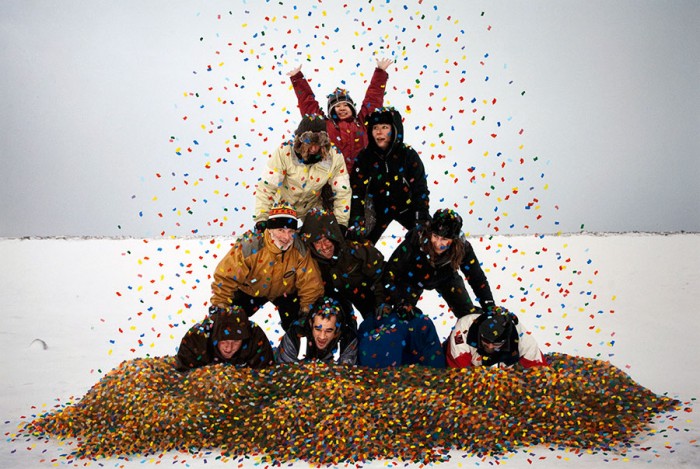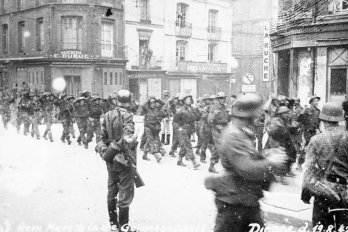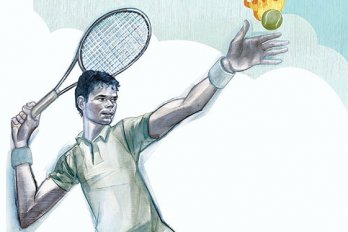The slickest curatorial move in Oh, Canada, the ebullient, thought-provoking, at times maddeningly squirrelly survey of Canadian art at the Massachusetts Museum of Contemporary Art, turns up around the third gallery, in the guise of a scrappy looped video work by the Cedar Tavern Singers, an Alberta alt-folk-rock duo known for their wry musical send-ups of high culture. Here, they poke gentle fun at the absurdity of distilling the artistic identity of one nation into a comestible nugget for another. “What’s in store? Beyond those doors? What exactly is contemporary Canadian art? ” they wonder aloud, in singsong mock puzzlement, name-checking “neo-lumberjack abstraction” and “relational lacrosse,” among other kooky possibilities, as ragged 2-D cut-outs of moose and hockey players and Labatt bottles galumph across the screen past puckishly lo-fi backdrops.
As critiques go, the work skews lightweight, but that may be exactly the point. MASS MoCA curator Denise Markonish spent five years organizing the show for US audiences, a task fraught with programmatic challenges. But she clearly knew what she was up against with her fellow Americans—the attitudes, the shared experiences, the simplistic preconceptions they (full disclosure: we) would arrive with. By offering a vision of Canadiana as witty, as irreverent, as not too painfully earnest, the Cedar Tavern Singers’ absurdist romp undercuts (in two minutes and change) decades of entrenched Dudley Do-Right, the McKenzie brothers, and cornball pop singer stereotypes. Canadian artists are subversive, it says, with a pitch-perfect wink. They’re hip to a non-Morissettian irony (don’tcha think?). Most of all: they’re in on the joke. So keep that in mind, eh, while gawking at the snowscapes and Inuit drawings.
A Lacanian scholar would say something witty and wise here about inverting the gaze or empowering the Other. But appreciating the fresh perspective Markonish has teased out requires zero lit-crit posturing. You know it when you see it. It just feels right.
Throughout, Markonish keeps a tight rein on tone and pacing. This is a fun exhibit. There’s hardly a dull moment. Only a few works devolve into preachy or cryptic tedium.
The problem—and to my mind, it’s a doozy—is the lineup. These aren’t the big guns of Canadian contemporary art, which may not dawn on you until you’ve taken in the bulk of the show, perhaps because of the exceptions dropped in here and there: a Garry Neill Kennedy in the third room, an Eric Cameron a few galleries down. That’s assuming you’re a clued-in Canadian. It’s a safe bet that most Americans won’t have an inkling that David Hoffos, Sarah Anne Johnson, and Joseph Tisiga aren’t household names north of the border, given the real estate Markonish accords them. As a friend dryly observed during our second pass through the galleries, “The deep-tracks aspect gets kind of lost if you’ve never heard the album.”
Does it matter that Canadian art newbies will miss out on such canonical figures as Janet Cardiff and George Bures Miller? And whither Jeff Wall, and what of the fact that only four of the sixty-two artists and collectives hail from his native British Columbia, arguably the contemporary art hotbed of the nation? To be fair, Markonish acknowledges at every turn—on the opening wall text, in the catalogue essay, in press quotes—her decision to focus on lesser-known artists. That said, in place of an orthodox organizing principle one might reasonably expect to find (what’s the term?) an unorthodox organizing principle instead. And therein lies the problem: the absence of any clear curatorial thesis.
“The exhibition is not really about a thematic approach but, more so, showcasing great work that happens to be made by Canadians,” Markonish explained during an email exchange. “All in all, it is a more quirky view, which reflects my personal taste.”
Her candour is admirable. It doesn’t, however, change the uncomfortable realization that we’re left, sans rationale or context, with a haphazard, 100-strong parade of Denise Markonish’s favourite souvenirs from her three-year tour of Canadian studios. With nary a thematic signpost to spoil the fun, landscapes mingle with sculpture, portraitists share wall space with videographers, octogenarian Torontonians bunk with twentysomethings from Yukon. It’s a taxonomic free-for-all: come on down!
Even Joseph Thompson, the museum’s normally eloquent director, seems to have been rendered temporarily tongue tied by the nebulous nature of the beast: “At a moment in the international art scene that is particularly attuned to the exotically remote and embracing of ‘anti-aesthetics,’ ” he mustered for the press release, “this is a show of art from close to the United States, often beautifully made.” Which, um, yes. It is… often.
But try slapping that endorsement across a banner.
The upside to Markonish’s ecumenical approach is that her choice of works is unencumbered by a need to flesh out some narrative thread with ersatz placeholders. Happily devoid of those minor-Cassatt-loan-to-show-the-spread-of-Impressionism moments that dilute typical retrospectives, the exhibition ends up long on powerful, provocative pieces. Organizational rigour be damned, Markonish has excellent taste. (The downside: the clunkers are all on her, too; more on that below.)
By and large, the multimedia installations shine brightest here. Among the most arresting is Scenes from the House Dream (2005–08), by Lethbridge, Alberta, artist David Hoffos, who combines single-channel video and miniaturist dioramas, set up in cramped alcoves in the wall, to create three disturbingly realistic vignettes that conjure every anxiety nightmare you’ve ever had. The first two scenes happen to be set in an eerie forest cut through by a train track (complete with model train), with an open kitchen window that keeps letting in the snow, but they could just as easily have involved losing teeth while writing an exam for a never-attended class. Then—yikes!—you notice the faint full-scale apparition of a woman trembling in the far corner of the room you’re in, so lifelike it could be a fellow visitor cooling off after a quarrel (or an overdose). Paranoid claustrophobics will hate this one.
A few pieces harness old-school or obsolescent technologies in a gently nostalgic (and gently ironic) way. Montreal’s Daniel Barrow corrals half a dozen low-tech overhead projectors, some manipulated to hold a distorting layer of water, to beam phantasmagoric cartoons drawn on acetate transparencies across a multi-layered cinematic backdrop in The Thief of Mirrors (2011), a room-swallowing tour de force. Toronto’s Kristan Horton references animation’s early stop-motion fumblings in Haptic Sessions ed #1/3 (2010–11), rigging up facing flatbed scanners to choreograph an intricate dance of increasingly numerous objects (a lighter, a rubber glove, a piece of candy, and so on), which culminates in a crowded, frenetic bacchanalia that classical music fans might liken to the stretto finale of a fugue. There’s improbable elegance in the quaint herky-jerky movements, and the virtuosic interplay of textures, forms, and colours is breathtaking.
One work likely to top the list for hardened critics and casual looky-loos alike is Quebec artist Diane Landry’s charming Knight of Infinite Resignation (2009), a field of Ferris wheel–like constructions encircled by light bulbs she fashioned from recycled plastic bottles. As the automated wheels spin and bounce light forms around the darkened gallery, sand in the bottles slides back and forth, evoking the hourglass and all of its temporal associations. The carnival imagery appears straightforward enough, but if this is precisely how the first post–end time flower garden turns out looking, I wouldn’t be shocked at all.
The award for unplugged spookiness goes to Toronto’s Shary Boyle, whose ink and gouache drawing Blodie Is Born Again, and Born Again (2009) reads as a self-contained, Blakean mythscape of gruesome horrors: the deformed, gnarled body of the sanguine title heroine gives birth to a bloody limb, as a backdrop of strangely mammalian vegetation (is that hair? or grass?) all but seethes in primordial sympathy. In grey-scale but for the occasional dab of blue, green, yellow, or washed-out red, it reads like Thomas Kinkade highlighting gone frighteningly askew.
The quieter gems, too, pack an expressive wallop. St. John’s photographer Ned Pratt’s glorious shots of Newfoundland—the 2008 Façade, Northern Peninsula is particularly stunning; channel the cool, detached, yet texture-driven formal poetry of latter-day abstract painting (specifically the post-minimalist Agnes Martin, for those playing at home…). Yet there’s also an unmistakable tension, born of the uneasy sense that at any moment capital-N Nature could come crashing through, busting the clean lines of the implied modernist grid to smithereens.
Tackling annihilation of a more tragic ilk, Ruth Cuthand, a First Nations artist from Saskatoon, demonstrates that stony-faced earnestness is not the only mode for addressing colonialism’s complicated history. At first glance, the works in her wry Surviving… series (2011) appear to be polished abstract expressionist paintings, which makes it all the more devastating to realize that they’re blown-up likenesses— rendered in intricate glass beadwork, a nod to craft traditions—of microscopic diseases (hantavirus, hepatitis, West Nile) that have decimated Aboriginal communities.
For those who prefer to contemplate revisionist history from a safer distance, David R. Harper’s Finding Yourself in Someone Else’s Utopia (2011–12) purports to aim the finger wagging at those insensitive brutes of the Flemish baroque. For this whip-smart, stylish allegory, the Toronto native considers the classic hunting scene from the prey’s point of view, wall-mounting a reproduction of Frans Snyders’ early seventeenth-century canvas Wild Boar Hunt, but with the boar obscured by a white patch embroidered into the canvas. In a slick, cunning move, Harper places the boar in the viewer’s position, in the form of a life-sized taxidermic specimen wrought from animal hides dyed blue and decorative cast resin. Sitting next to the boar is the work’s third component, a geodesic half-dome made from cast resin bones, which I haven’t quite figured out but I suspect is some sort of riff on Buckminster Fuller and utopian philosophies and—wait, who made the decision to scrap the explanatory wall placards, again?
The show contains too many knockouts to give them their due in this space (a minor quibble: the exhibition is probably overcrowded by about 15 percent). But for those who can see it before it closes next April, here’s a quick hit list of works worth special attention: Chrysalide Empereur (2007–08), a harrowing, near-operatic film noir that stars a drowning car and a cigarette-smoking Ronald McDonald, by Patrick Bernatchez of Montreal; Whitehorse artist Joseph Tisiga’s profound, exquisite series (2012) of watercolour collages, which explore notions of the loaded term “native”; and Iiniiwahkiimah (2012), a stylized fresco of a buffalo rendered in black vinyl (a petroleum by-product) by Calgary’s Terrance Houle, with the oil cans that ostensibly contained the paint dumped—accusingly—on the floor beneath it.
The overwhelming majority of pieces are so strong that it does the duds no favours. Happily, by and large, the weaknesses aren’t categorical. More often, they’re underwhelming one-offs that don’t quite click—or, worse, exude an “is this clever or what!” smugness that undercuts the gesture and simultaneously, often fatally, raises the bar.
Cause- and identity-themed works seem most susceptible to expressive anemia, as though the noble message trumps the efficacy of its packaging. Wally Dion’s Game Over (2011), a circuit board reassembled so the paths form a tribal pattern, feels like the first tentative utterances in a conversation about First Nations identity issues, but it doesn’t complete the thought, abandoning viewers to connect the referential strands themselves (as in: “Technology. Displaced tribes. Am I right? “). Valérie Blass’s She Was a Big Success (2009), a twisted wood and Styrofoam sculpture of a naked, bewigged woman with stiletto-shaped feet, serves up a desultory rehash of the feminist trope about objectification in the workplace—already done far more eloquently by Laurie Simmons. Rebecca Belmore’s Eagle Drum (2012), which consists of looped video footage of an eagle broadcast onto an oil drum, grapples facilely with environmentalism but adds nothing new to the dialogue.
Other misses: Myfanwy MacLeod’s triptych Michael, Carrie, Rosemary (2010), movie posters cut into snowflake forms, is a lame idea writ thrice. Why include Hans Wendt’s throwback, if technically sound, trompe l’oeil watercolours in a contemporary Canadian art survey? And speaking of the past, if an argument exists for resurrecting the late baroque term “mannerist,” it’s big gun Michael Snow’s phoned-in Solar Breath (Northern Caryatids) (2002), sixty-two minutes of unmanipulated still camera footage of curtains fluttering in a cabin in the Maritimes. (A quick plug for my own latest effort: a found object assemblage titled Messy Journalist’s Notebook with Coffee Mug and Cellphone .)
Three final general observations to file under random quibbles: First, painting, as a category, is weak in this exhibition. If Douglas Coupland, Andrea Mortson, Janet Werner, and Etienne Zack represent the cream of the Canadian crop, then—in the absence of helpful wall placards to offer context—Americans may very well conclude, rightly or wrongly, that the medium is not our northern neighbour’s strong suit. (To be fair, I’ve seen better canvases by Werner, the only one of the four I was familiar with.) Second, incorporating looped film footage into an installation can be an effective and resonant expressive gesture—except when it makes a hollow attempt to spruce up an otherwise garden-variety work with stylish, high-tech trappings. Finally, including Canadians who work primarily in Berlin (Hadley+Maxwell), New York (Marcel Dzama), and Chicago (David R. Harper) in a show for which the low bar of entry is “artists working in Canada” feels a little bit like cheating.
In November 2010, the Museum of Fine Arts, Boston—another august Massachusetts institution—opened the doors of its shiny new $345-million Art of the Americas wing. It was an ambitious undertaking, for the breadth of its scope—the art and decorative objects of South, Central, and North America, from the pre-Columbian era through the mid–twentieth century— as well as for its novel organization. Breaking from the usual convention of grouping pieces by nationality, genre, or medium (which tended to ghettoize non–European immigrant works in distant side galleries), the curator decided to arrange the 5,000-plus disparate objects strictly by chronology. It was brave; it was boldly egalitarian. It just made sense.
Which, quite naturally, meant the critics hated it. It’s naively encyclopedic! they groused at the time. A museum should play to its strengths! Could there be weaker examples of French colonial artifacts? They’re just highlighting the gaps this way! From the local papers and the art blogs to national publications like The Economist and the Wall Street Journal , the consensus seemed to be that the poor, deluded MFA had made an embarrassing tactical decision. And it was arranged badly, to boot.
However, one critic, the Boston Globe‘s normally tough-as-nails Sebastian Smee, came to the museum’s defence. After conceding that the MFA had indeed bitten off way more than it could chew, that the early modern era works were “blowsy and third-rate,” and that when it came to Spanish colonial artifacts and Canadian art in general (sorry!) the curators were starting virtually from scratch, he went on to argue that such criticisms, however valid, miss the point. That you’ve got to start somewhere and build from there. That no progress can be made unless someone begins the conversation, however flawed or less than perfectly honed the first sentence turns out to be.
Of course, the MFA is building a permanent collection. Its curators can address the problems, even spinning the gap-ridden nature of the sparkling, sprawling new venue as a positive—something to attract gifts from collectors who might previously have worried their bequests would languish somewhere in storage. By contrast, in Oh, Canada MASS MoCA offers up an exhibition that will be gone in under a year; it is what it is, in all its glorious, exuberant, unparsed randomness.
“What exactly is contemporary Canadian art? ” asks the Cedar Tavern Singers’ catchy refrain, so infectious you’ll be humming it in the car on the way home. (No, seriously: the duo could teach earworm lessons to Carly Rae Jepsen.) Well, it’s this, and it’s also not this, and, you know, maybe that’s all well and good at the end of the day. If it takes a quirky Markonish-fest to galvanize interest in Canada’s artistic output—even dialectical interest—from its southern neighbour, maybe the exhibition has accomplished what it set out to do in the first place. In the introductory text splayed out on the wall at the show’s entrance, Markonish seems to hope as much. “In the end, Oh, Canada serves as a new kind of travel guide; one snapshot among many possibilities to encourage dialogue, debate, and a deeper exploration of Canadian art today.”
Fair enough. Consider it encouraged.
This appeared in the September 2012 issue.





